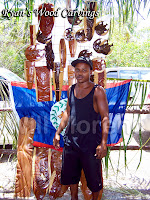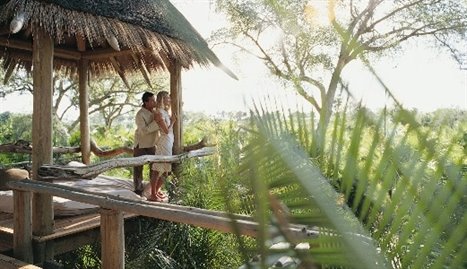By: Will Moreno
May 22nd, 2011
After an exhilarating opening night for the Toledo Cacao Festival in Punta Gorda Town, waking up to the waves crashing ashore and the birds chirping in the trees was truly a peaceful beginning. While getting ready for what we knew was going to be a long day, and reviewing all the activities of the day in the Toledo Howler. We quickly realized that the activities were spread out throughout the whole town and at different time intervals. We had to strategically plan how to be in attendance at most of the events, and we knew we could certainly not attend all the events.
We noticed the small town waking up and becoming alive with people who wanted to see more chocolate treats. The Events for the day, according to the timetable, started around 8 a.m. at the Fajina Craft Center, where we observed various Mayan Artisans displaying their lovely crafts of basket weaving, Mayan tapestry, wood carvings among other things all while wearing their traditional Mayan dresses. There were also individuals selling locally produced garifuna crafts, dolls and the famous Noni juice.

Knowing earlier that we had very little time between events, we then made our way to the Texaco pier where the triathalon was about to get underway. On our way there we passed by the chocolate center where the many chococolate by-products were being displayed. Some other products that were being displayed were the copal soaps and oils as well as paintings. As we arrived to the Pier participants were stretching and getting ready for a 250m swim, before biking 6 miles and then running 2 miles to the finish line. Participants came from a wide cross section of the community including famous Belizean athletes such as Shalini Zabaneh, Jim Scott (general manager of Radisson Hotel), and youths from Belize High School in Belize City, who made the 4 hour trip just to compete in this event. The Triathalon showed the drive of the participants who pushed their endurance until the very end to get to the finish line and absolutely no one gave in to fatigue. All participants finished the race by crossing the finish line on their own determination and energy.

After a short lunch break, we resumed the tour of Punta Gorda Town and made our way near the airstip to Maya Bags. Maya Bags is an organization producing high quality, hand embroidered bags which are selling in major US stores such as Barney's New York among others. They also exhibit their bags and collectibles by local Mayan Artisans and have recently been featured in news articles abroad: Maya Bags. Looking at the finished products were great and even better to see how tedious the work was to create each and every bag. Some handles were intricately woven like baskets, while others were made of coconut shell rings joined together and some woven of fine threads. Each and every bag is definitely a labor of love.

Wanting to enjoy the rest of the day, we made our way back to front street where we came across a rythmic group of drummers and dancers performing for the crowds who stood in the streets of Punta Gorda. The group was that of Mr. Emmeth Young who has a drum school in San Pedro Columbia in Toledo. We stood by and watched the dancers swaying to the harmonious beats of the hand made drums. They entertained the crowds for quite a while with the wonderful drums and dances.

Knowing we had a long night ahead of us we went back to where we were staying and were very happy at the thought of having coconut water straight from the coconut itself. Coconut Water also called "Koknat Wata" is sweet tasting and very refreshing after a long hot day. It is said to have lots of nutrients and great for the health of your kidneys. After having the water, the cocunuts were chopped into halves and we ate the fleshy white pulp in the center which is very sweet and milky. We also tried a new fruit called the jackfruit that we had never tasted before. It smells like ripe plantains and taste like a cross between ripe plantains, papaya and pineapple. The fruit grows like a soursop with a spikey outer pod and inside it has a yellowish pulpy fruit which contains the seeds that can be boiled and enjoyed as a healthy snack.

The nights in Punta Gorda are very peaceful and cool however we were ready to dance and have a night of fun so we decided to go to Waluco's around 9:30 PM. From our understanding, Waluco's got packed as the night progressed. When we got there, it was very quiet so we decided to go to Reef Bar and were not disappointed with the old school music playing at the bar. After a while they let the band Chukuro and the Tribal Vibes start their Garifuna drumming. The band is led by Mr. Ray Arzu who teaches kids the art of drumming and has led them to win the coveted title for battle of the Drums 2 years in a row in 2009 and 2010. This night he has 2 juniors with him ages 9 and 10 showcasing their great talent with the segunda drum (base drum), the primero drums (lead drum)and the shakka (calabash rattles). When the rhythm is paired with cold Belikin beers, the feet start shuffling and the body starts moving with the rhythm. Getting on the floor and dancing was so much fun while moving to the beating of the drums. Mr Arzu definitely educated us about the difference in the Garifuna music. He told us that the Garifuna music was broken into six different rhythms. The first of those rhythms was the 'Paranga' which is a slow warm up followed by the 'Huguh Huguh' which is a slow rhthm that is usually used in the temples. He then told us about the 'Chumba' which is drumming music based on the dancers actions and the drummers have to match their every move. The drumming then changed to one that most Belizeans are familiar with and it was the 'Punta' which is a fast beat that is very synonymous with the Garifuna culture and the Garinagu people. Next there is the 'Wanaragua' beat which is a fast paced drumming beat usually used by the Jankunu dancers who dress like their colonial slave masters and danced around. Finally there was the 'Sambe' which is a drumming to call on the 'Sisters' for blessings. The beat continued late into the night as we shuffled to different drumming beats on the floor.

We knew the following day was going to be another fun day at the Cacao Festival at the Lubaantun Maya Ruin. Come back and visit our blog again and we will tell you all about day three of the Toledo Cacao Festival in Punta Gorda, Belize. You can also read about day one here: Toledo Cacao Festival in Belize - Part 1.































































